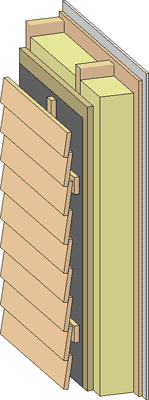Geprüftes/zugelassenes Bauteil
external wall awrhho07a-05
external wall timber frame construction, ventilated, without dry lining, with cladding
Building physical assessment
| Fire performance |
REI
from inside
REI from outside |
60
30 |
|---|---|---|
|
maximum ceiling height = 3 m; maximum load Ed,fi = 32,0 kN/m
Classified by MA39 Classified by HFA
Fire performance Germany
Classification: F60 (from inside/from outside)
Load Ed,fi according to the German certification document
Proof: manufacturer-specific
|
||
| Thermal performance | U | 0,19 W/(m2K) |
| Diffusion | adequate | |
|
Calculated by TUM
|
||
| Acoustic performance | Rw (C;Ctr) | 46 dB (-2; -8) |
| Ln,w (Cl) | ||
|
Assessed by MA39
Rating by Müller-BBM
|
||
| Mass per unit area | m | 56,4 kg/m2 |
|
Calculation based on gypsum plaster board type DF GKF
|
||
data sheet external wall
awrhho07a-05 (pdf, 250 KB)
Note
According to OIB-RL 2 (Austria) is for ventilated and insulated facades (from building class 2) an insulation material with minimum Euroclass D required.
Only for registered members after logging in.


Register of building materials used for this application, cross-section (from outside to inside)
| Thickness [mm] | Building material | Thermal performance | Reaction to fireklasse EN | ||||
|---|---|---|---|---|---|---|---|
| λ | μ min – max | ρ | c | ||||
| A | 24,0 | larch wood external wall cladding | 0,155 | 150 | 600 | 1,600 | D |
| B | 30,0 | spruce wood battens - ventilation | 0,120 | 50 | 450 | 1,600 | D |
| C | 30,0 | spruce wood cross battens | 0,120 | 50 | 450 | 1,600 | D |
| D | wind barrier | 1000 | |||||
| E | 60,0 | wood-fibre insulation board [045; 140] | 0,045 | 2-5 | 140 | 2,100 | E |
| F | 160,0 | construction timber (60/..; e=625) | 0,120 | 50 | 450 | 1,600 | D |
| G | 160,0 | mineral wool [040; 33; ≥1000°C] | 0,040 | 1 | 33 | 1,030 | A1 |
| H | 15,0 | OSB (sealed with airtight tape) | 0,130 | 200 | 600 | 1,700 | D |
| I | 12,5 | gypsum plaster board type DF or | 0,250 | 10 | 800 | 1,050 | A2 |
| I | 12,5 | gypsum fibre board | 0,320 | 21 | 1000 | 1,100 | A2 |
Ecological rating (per m2 construction area)
Details of sustainability rating...
| Global warming potential | Share of renewable Primary Energy | Resources | |||||||||||
|---|---|---|---|---|---|---|---|---|---|---|---|---|---|
| Lifecycle Phase |
GWP-F [kgCO2Äqv.] |
GWP-B [kgCO2Äqv.] |
GWP-T [kgCO2Äqv.] |
PERE [MJ] |
PERM [MJ] |
PERT [MJ] |
PENRE [MJ] |
PENRM [MJ] |
PENRT [MJ] |
AP [kgSO2Äqv.] |
EP [kgPO4Äqv.] |
ODP [kgR11Äqv.] |
POCP [kgEthenÄqv.] |
| A1 - A3 | 29,085 | -63,711 | -34,626 | 118,405 | 656,751 | 775,156 | 429,222 | 29,328 | 458,550 | 0,153 | 0,057 | 2.0156856E-6 | 0,049 |
Details of sustainability rating...
| Resources | |||||||||||
|---|---|---|---|---|---|---|---|---|---|---|---|
| Lifecycle Phase |
GWP [kgCO2Äqv.] |
AP [kgSO2Äqv.] |
EP [kgPO4Äqv.] |
ODP [kgR11Äqv.] |
POCP [kgEthenÄqv.] |
PERE [MJ] |
PERM [MJ] |
PERT [MJ] |
PENRE [MJ] |
PENRM [MJ] |
PENRT [MJ] |
| A1 - A3 | -43,589 | 0,103 | 0,017 | 7.52E-7 | 0,022 | 204,731 | 684,998 | 889,480 | 389,112 | 51,569 | 440,750 |
| C1 - C4 | 65,610 | 0,002 | 0,002 | 7.54E-8 | 0,000 | 1,064 | -679,038 | -677,974 | 13,639 | -17,012 | -3,370 |
| A1 - C4 | 23,989 | 0,107 | 0,020 | 8.36E-7 | 0,022 | 206,181 | 6,219 | 212,150 | 408,815 | 34,609 | 443,500 |
Last update 02.08.2023/hfa.eco2soft